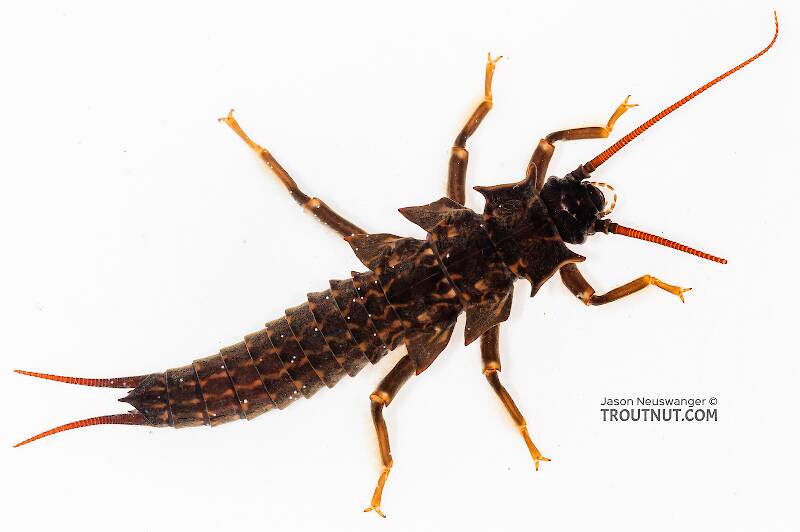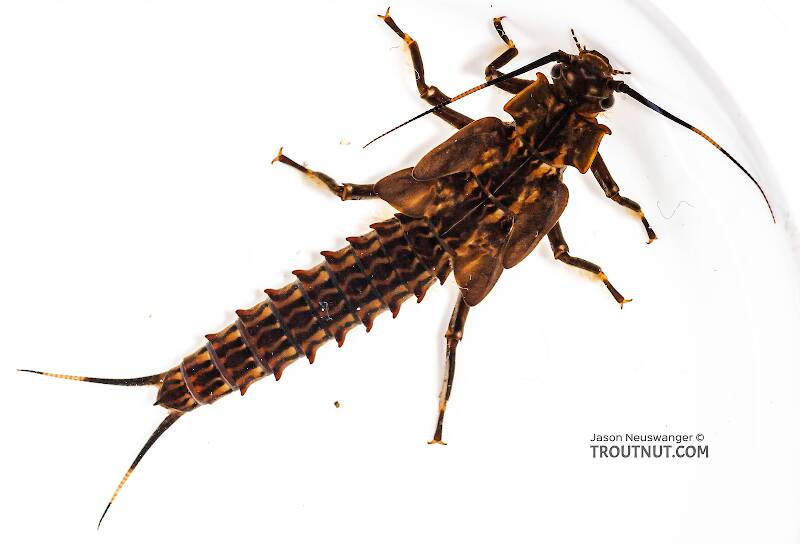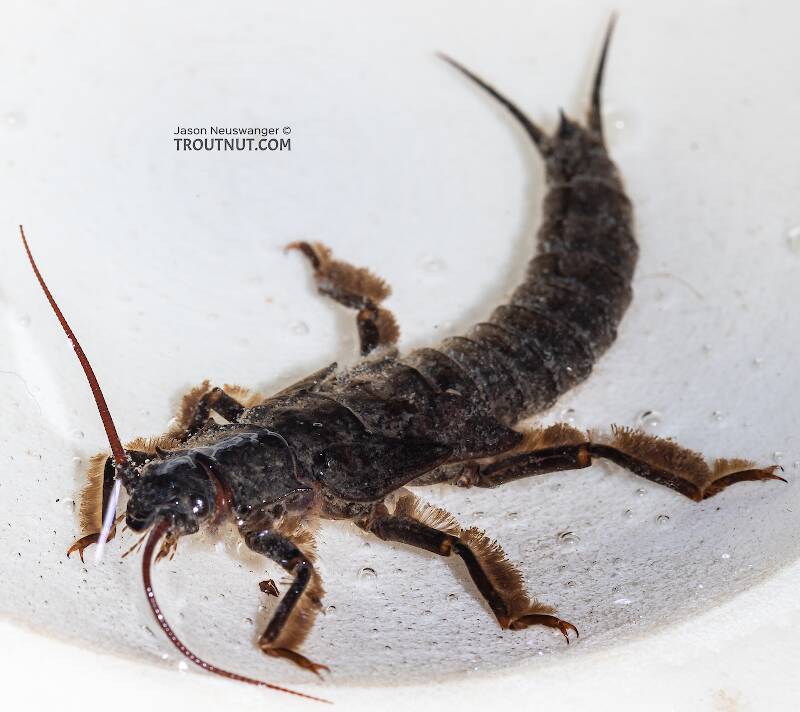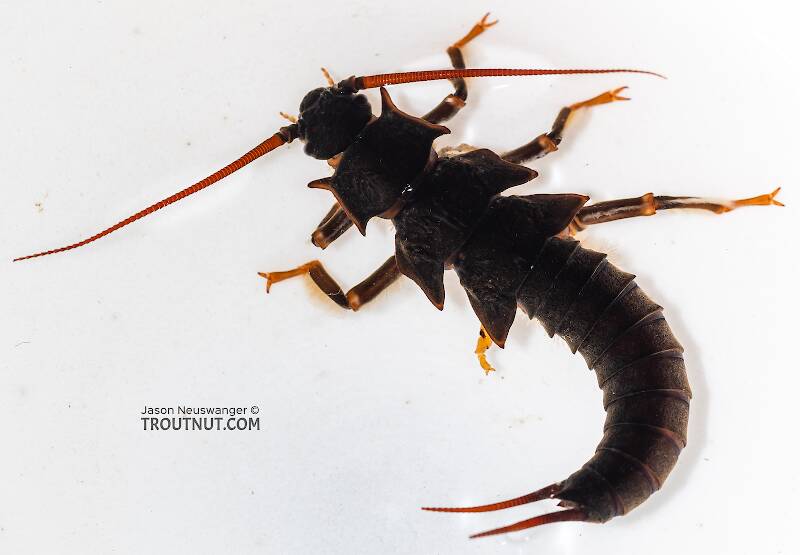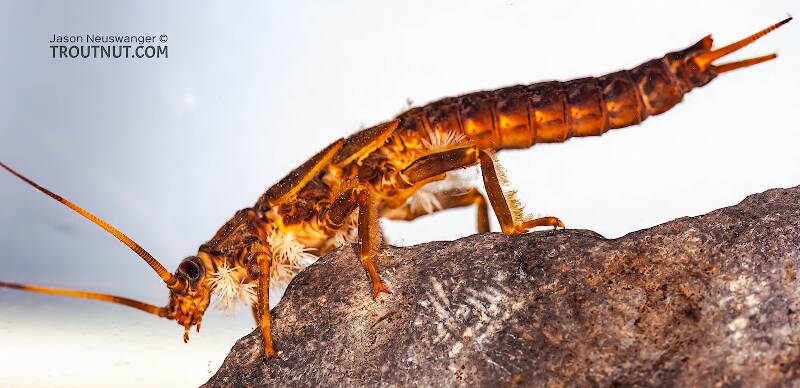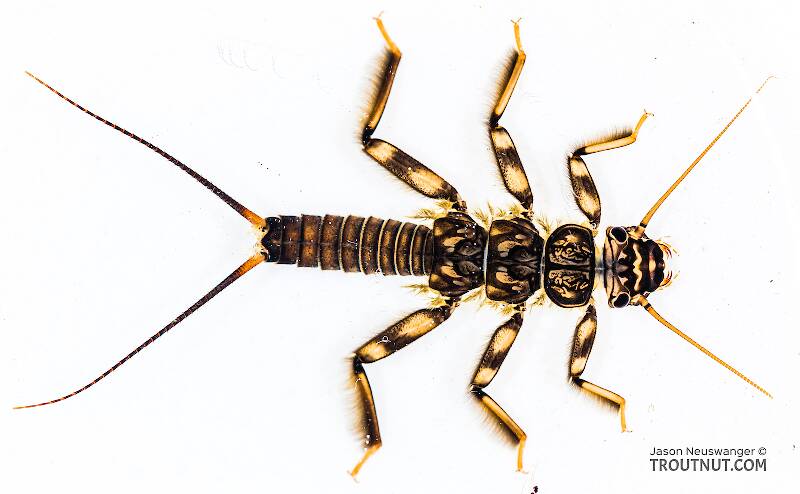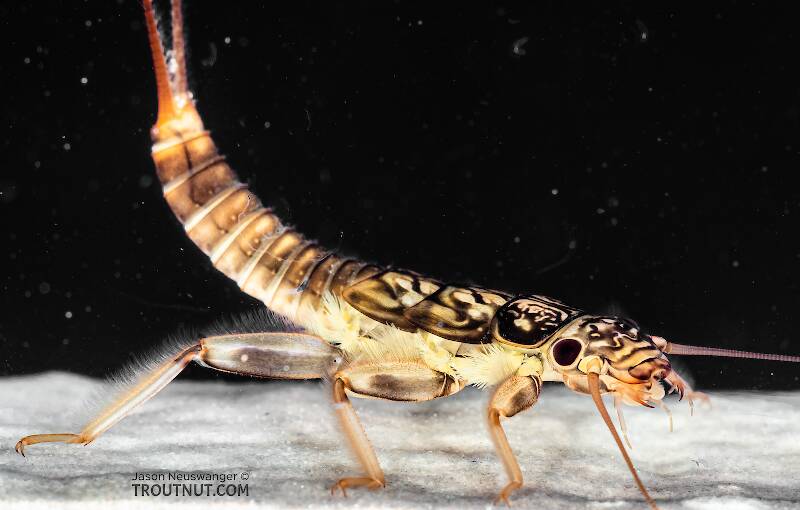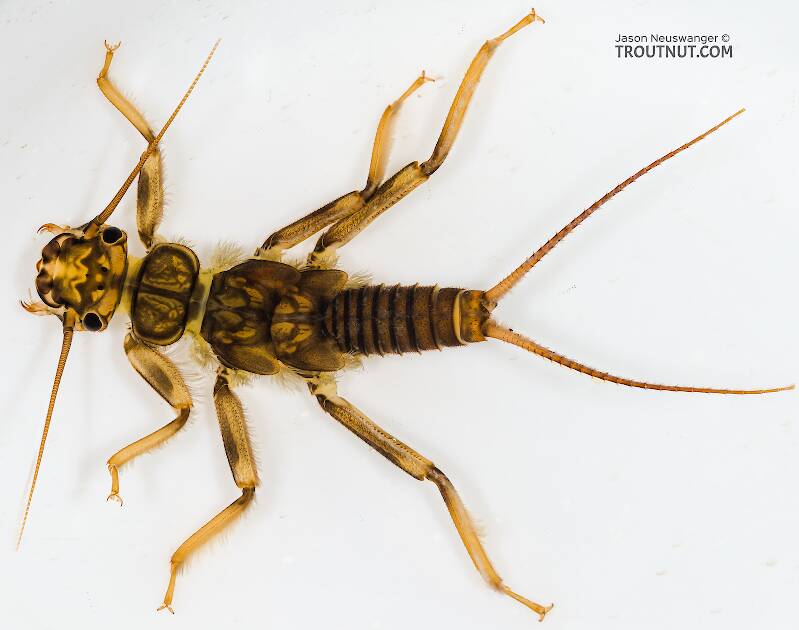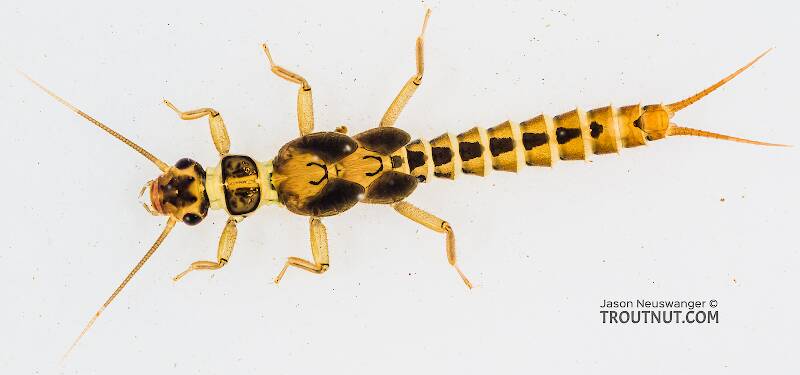
Hex Mayflies
Hexagenia limbata
The famous nocturnal Hex hatch of the Midwest (and a few other lucky locations) stirs to the surface mythically large brown trout that only touch streamers for the rest of the year.
Featured on the forum
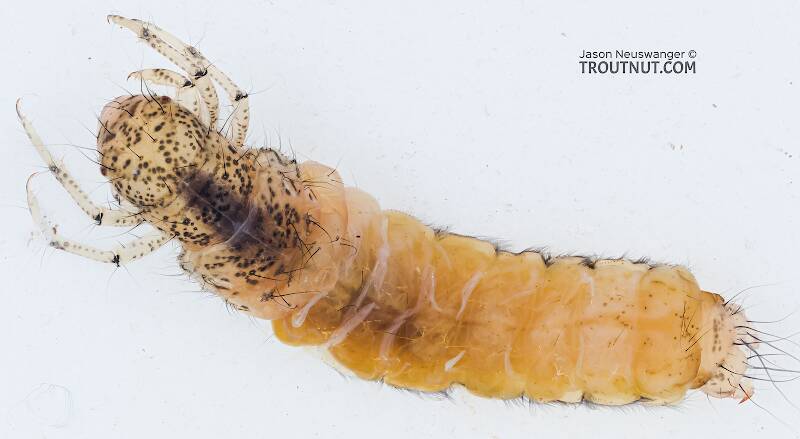
This is a striking caddis larva with an interesting color pattern on the head. Here are some characteristics I was able to see under the microscope, but could not easily expose for a picture:
- The prosternal horn is present.
- The mandible is clearly toothed, not formed into a uniform scraper blade.
- The seems to be only 2 major setae on the ventral edge of the hind femur.
- Chloride epithelia seem to be absent from the dorsal side of any abdominal segments.
Based on these characteristics and the ones more easily visible from the pictures, this seems to be Grammotaulius. The key's description of the case is spot-on: "Case cylindrical, made of longitudinally arranged sedge or similar leaves," as is the description of the markings on the head, "Dorsum of head light brownish yellow with numerous discrete, small, dark spots." The spot pattern on the head is a very good match to figure 19.312 of Merritt R.W., Cummins, K.W., and Berg, M.B. (2019). The species ID is based on Grammotaulius betteni being the only species of this genus known in Washington state.
- The prosternal horn is present.
- The mandible is clearly toothed, not formed into a uniform scraper blade.
- The seems to be only 2 major setae on the ventral edge of the hind femur.
- Chloride epithelia seem to be absent from the dorsal side of any abdominal segments.
Based on these characteristics and the ones more easily visible from the pictures, this seems to be Grammotaulius. The key's description of the case is spot-on: "Case cylindrical, made of longitudinally arranged sedge or similar leaves," as is the description of the markings on the head, "Dorsum of head light brownish yellow with numerous discrete, small, dark spots." The spot pattern on the head is a very good match to figure 19.312 of Merritt R.W., Cummins, K.W., and Berg, M.B. (2019). The species ID is based on Grammotaulius betteni being the only species of this genus known in Washington state.

Troutnut is a project started in 2003 by salmonid ecologist Jason "Troutnut" Neuswanger to help anglers and
fly tyers unabashedly embrace the entomological side of the sport. Learn more about Troutnut or
support the project for an enhanced experience here.
Identification: Key to Families of Stonefly Nymphs, Couplet 1
Identification: Key to Families of Stonefly Nymphs, Couplet 1
Error: Tried to access a key that isn't live.
Adapted from Merritt R.W., Cummins, K.W., and Berg, M.B. (2019)
| Option 1 | Option 2 |
|---|---|
Ventral gill tufts present on thorax and abdominal segments 1-2 or 1-3 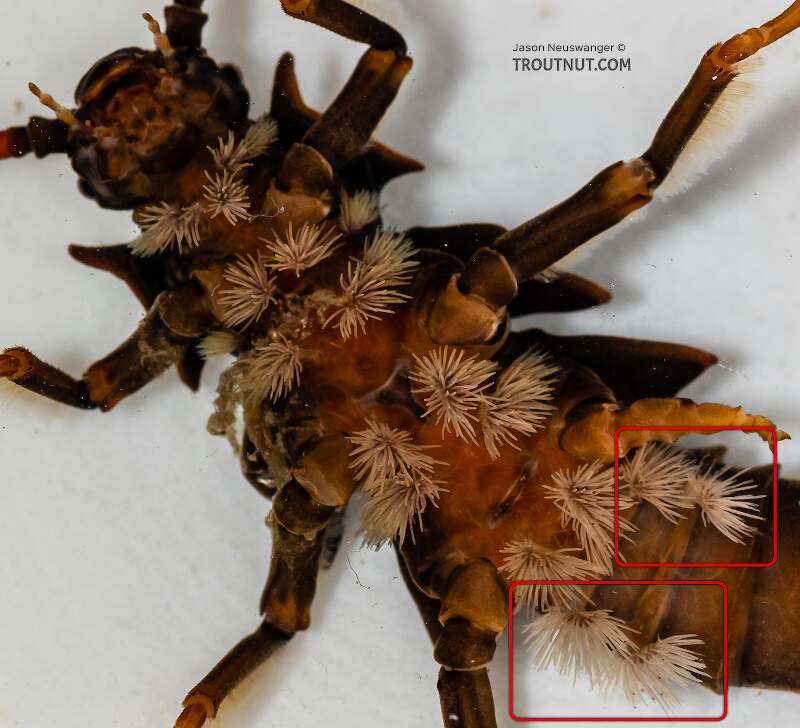
| Ventral gill tufts absent from abdominal segments 1-2 or 1-3 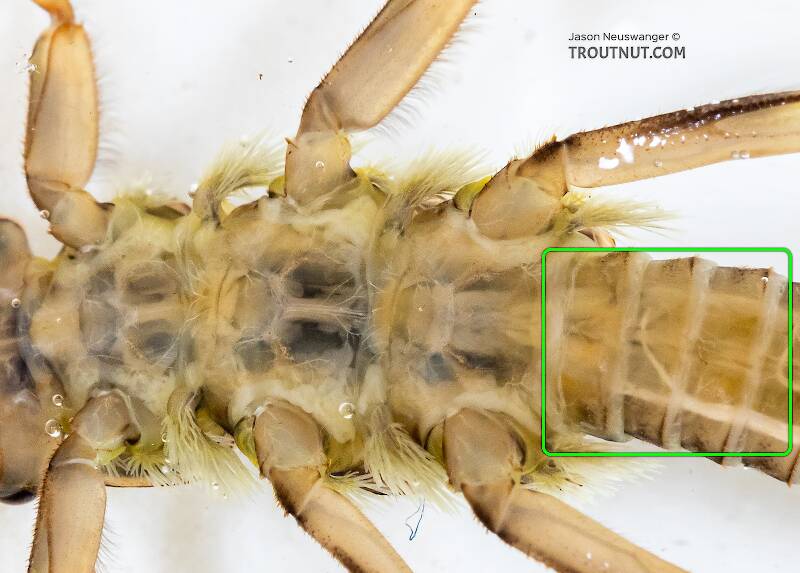
|
| Remaining families: Capniidae, Chloroperlidae, Leuctridae, Nemouridae, Peltoperlidae, Perlidae, Perlodidae, and Taeniopterygidae | |
5 Example Specimens | 5 Example Specimens |
| Pteronarcyidae | Go to Couplet 2 |
Adapted from Merritt R.W., Cummins, K.W., and Berg, M.B. (2019)
The current couplet is highlighted with darker colors and a icon, and couplets leading to this point have a icon.
Couplet 1 (You are here)
Leads to Pteronarcyidae:
- Ventral gill tufts present on thorax and abdominal segments 1-2 or 1-3
Leads to Couplet 2:
- Ventral gill tufts absent from abdominal segments 1-2 or 1-3
Couplet 2
Leads to Peltoperlidae:
- Single, double, or forked conical gills present at least behind coxae of second and third leg
- Thoracic sterna posteriorly produced, overlapping succeeding segment
- Some genera appear roach-like
Leads to Couplet 3:
- Gills, if present, not conical
- Thoracic sterna not overlapping
Couplet 3
Leads to Couplet 4:
- Paraglossae and glossae extend forward about the same distance (sf 16.18) (be careful not to confuse them with the labial palps, which might be large and partially obscuring these parts, as in the illustration)
Couplet 4
Leads to Couplet 7:
- Paraglossae much longer than glossae
Couplet 7
Leads to Taeniopterygidae:
- First and second tarsal segments near equal in length
- Midline of wing pads strongly divergent from body axis
- One genus often with each coxa bearing a single, segmented, ventrally directed, finger-like gill (sf 16.20) or abdomen terminating in a large, ventral, shield-like plate (sf 16.53)
Leads to Couplet 5:
- Second tarsal segment much shorter than first
- Midline of wing pads parallel or divergent
- No coxal finger-like gills nor large ventral, shield-like plate
Couplet 5
Leads to Nemouridae:
- Midline of metathoracic wing pads strongly divergent from body axis
- Usually robust and squat body, such that extended hind legs reach about to the tip of the abdomen
- Cervical gills present (sf 16.22-16.25) or absent
Leads to Couplet 6:
- Midline of metathoracic wingpads, if present, nearly parallel with body axis (sf 16.11-16.12)
- Elongate body, such that extended hind legs reach far short of the tip of the abdomen
- No cervical gills
Couplet 6
Leads to Capniidae:
- Postmentum small, its anterior portion not covering bases of maxillae (sf 16.26)
- Terga and sterna of abdominal segments 1-9 separated by membraneous pleural fold (sf 16.28)
- Abdominal segments widest posteriorly
- Hind wingpads about as broad as long (sf 16.30-16.31), reduced, or absent
- Abdominal terga always with a posterior setal fringe (sf 16.32)
Leads to Leuctridae:
- Postmentum large, with its anterior portion partially covering basis of maxillae (sf 16.27)
- At most, abdominal segments 1-7 separated by membraneous pleural fold (sf 16.29)
- Abdominal segments uniformly cylindrical
- Hind wing pads usually longer than wide (sf 16.12)
- Abdominal terga of some genera (Despaxia, Perlomyia, Paraleuctra, and Zealuctra) without a posterior setal fringe
Leads to Chloroperlidae:
- Apical maxillary palpal segment small, asymmetrically set on penultimate segment
- Tails 3/4 or less the length of the abdomen
- Head and thoracic terga usually without a distinct pattern of dark and light pigments
Leads to Perlodidae:
- Apical maxillary palpal segment subequal in length to penultimate segment and symmetrically attached
- Tails more than 3/4 the length of the abdomen
- Head and thoracic terga usually with a distinct pattern of dark and light pigments
Start a Discussion of this Couplet
References
- Merritt R.W., Cummins, K.W., and Berg, M.B. 2019. An Introduction to the Aquatic Insects of North America (Fifth Edition). Kendall/Hunt Publishing Company.


